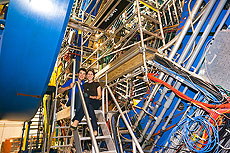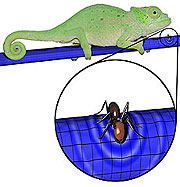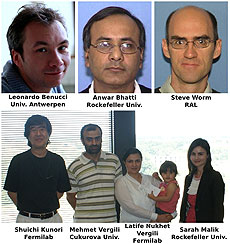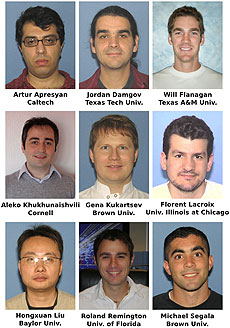|
Have a safe day!
Friday, July 22
3 p.m.
DIRECTOR'S COFFEE BREAK - 2nd Flr X-Over
3:30 p.m.
Joint Experimental-Theoretical Physics Seminar - One West
Speakers: Marco Verzocchi, Fermilab, and Ankush Mitra, University of Taiwan
Title: New Results from CDF and DZero for EPS-HEP 2011
Monday, July 25
PARTICLE ASTROPHYSICS SEMINARS WILL RESUME IN THE FALL
2 p.m.
LHC Physics Center Topic of the Week Seminar - Sunrise WH11NE
Speaker: Daniel Elvira, Fermilab
Title: SUSY Searches III: CMS Results
2:30 p.m.
Joint Experimental-Theoretical Physics Seminar - One West
Speaker: Douglas Orbaker, University of Rochester
Title: Forward-Backward Asymmetry in Top Quark-Antiquark Production in Proton-Antiproton Collisions at DZero
3:30 p.m.
DIRECTOR'S COFFEE BREAK - 2nd Flr X-Over
4 p.m.
All Experimenters' Meeting - Curia II
Special Topic: Hollow Electron-Beam Collimation Progress Curia II
Click here for NALCAL,
a weekly calendar with links to additional information.
Upcoming conferences
|
|
Friday, July 22
- Breakfast: Chorizo burrito
- Smart cuisine: Italian vegetable soup
- Chicken fajita sandwich
- Southern-fried chicken
- Smart cuisine: Mediterranean baked tilapia
- Eggplant parmesan panini
- Assorted sliced pizza
- Assorted sub sandwiches
Wilson Hall Cafe Menu
|
|
Friday, July 22
Dinner
Closed
Wednesday, July 27
Lunch
- Six-cheese & bacon stuffed shells
- Garden herb salad w/ roasted shallot vinaigrette
- Fresh fruit plate
Chez Leon Menu
Call x3524 to make your reservation. |
|
Wealth of particle physics data yields numerous results for EPS conference
Fermilab’s Tevatron particle collider is nearing the end of its lifetime, but results from its two collider experiments are nowhere close to dwindling. Members of the CDF and DZero collaborations at Fermilab will present a record number of results at this month’s European Physical Society conference on High-Energy Physics, which begins on July 21 in Grenoble, France.
Collaborators from the CMS experiment at the LHC will also present numerous results following a successful start to the LHC running in 2011. Fermilab is the host laboratory for the U.S. group participating in the CMS experiment and plays a major role in the operation of the detector and the analysis of the experiment’s collision data.
Fermilab’s MINOS experiment will present its result on the transformation of muon neutrinos into electron neutrinos, which constrained a measurement reported earlier by the Japanese T2K experiment.
Results from CDF will include the first observation of a new, heavy relative of the neutron as well as a first indication of the extremely rare decay of particles containing a bottom and a strange quark into two muons. This might shed light on the existence of yet unknown particles. DZero will present an update on a tantalizing hint of a new type of matter-antimatter asymmetry and present numerous measurements of properties of the top quark, the heaviest known elementary particle. Both CDF and DZero will provide updates on their search for the Higgs boson, which, if it exists, will explain why some elementary particles have mass and others don’t.
CDF and DZero spokespersons attribute the rush of new results to several things, including the record size of the data set produced by the Tevatron collider, and the improved data analysis techniques developed and employed by hundreds of scientists and the friendly competition with physicists working at the Large Hadron Collider, who are sifting through a quickly growing set of LHC data.
Read more
— Rhianna Wisniewski
|
Tevatron experiments close in on favored Higgs mass range
Experiments at the Department of Energy’s Fermilab are close to reaching the critical sensitivity that is necessary to look for the existence of a light Higgs particle. Scientists from both the CDF and DZero collider experiments at Fermilab will present their new Higgs search results at the EPS High-Energy Physics conference, held in Grenoble, France, from July 21-27.
The Higgs particle, if it exists, most likely has a mass between 114-137 GeV/c2, about 100 times the mass of a proton. This predicted mass range is based on stringent constraints established by earlier measurements, including the highest precision measurements of the top quark and W boson masses, made by Tevatron experiments. If the Higgs particle does not exist, Fermilab’s Tevatron experiments are on track to rule out this Higgs mass range in 2012.
Read more
|
SSVSP final steps
Fermilab entered today the final step of the self-select voluntary separation program. A total of 58 individuals applied and did not rescind their applications. Of those 58, laboratory management was able to accept 44 applications. By the end of the day, all individuals who applied will have been notified of their acceptance or denial.
Accepted individuals will separate from the laboratory on dates between Aug. 8 and Oct. 7. An employee’s separation date was determined by their division, section or center head with input from that individual’s supervisor. More information on the SSVSP process is available on the website.
Fermilab management and DOE will now discuss the next necessary steps.
|
Former Fermilab Today interns get engaged at RHIC - July 15
 |
|
Dave Mosher and Kendra Snyder met at a Fermilab intern reunion at the 2009 AAAS conference. They are pictured here soon after Dave popped the question in the RHIC detector at Brookhaven National Labratory. Click to see the "nerdiest engagement ever," as Dave and Kendra call it. Photo: Courtesy Dave Mosher. |
|
U.S. science is going the way of the shuttle
From the Inquirer Digital Blog,
July 21, 2011
Large-scale research has been beset by budget cuts.
A little more than 50 years ago, a charismatic young president presented Congress with his bold plan to land a man on the moon within a decade, saying, "Now it is . . . time for this nation to take a clearly leading role in space achievement, which in many ways may hold the key to our future on Earth."
Today, even with another youthful, research-friendly president at the helm, the future of American space exploration and large-scale science in general is in great peril. Atlantis' expected return to Earth Thursday, bringing the space-shuttle program to an end, is emblematic of the United States' diminishing role as a bearer of the scientific flame.
The money saved by retiring the shuttles was supposed to have been channeled into a renewed mission to the moon. Funding for that was cut in 2010, however, leaving U.S. manned spaceflight (beyond the International Space Station's orbit) in limbo.
Read more
|
|
Stricter bounds on extra dimensions
 |
|
What looks like a one-dimensional world to a large creature might actually be two-dimensional at smaller scales.
|
One of the goals of the LHC is to search for evidence of extra dimensions— spatial directions such as length, breadth and height, but curled or curved in a way that hides their existence in everyday life. In a recent paper, CMS scientists presented new bounds on such a scenario.
Extra dimensions could hide from our perception by curling into tiny loops. A particle that drifts a microscopic distance in this new direction would circumnavigate the loop and arrive at its starting point almost immediately. The universe might have several microscopic dimensions in addition to the three large dimensions that we know well.
Collisions in the LHC could reveal new dimensions by creating particles that are small enough to fit inside them. High-energy colliders are often called microscopes because the energetic particles they make fill less space than low-energy particles, which allows them to probe the smallest structures in nature. If extra dimensions exist, then some energy would seem to disappear from view as particles traverse the tiny loops. In the CMS detector, this would look like an energy imbalance in the highest-energy collisions.
In this analysis, the scientists studied collisions resulting in a large energy imbalance. Their observations are consistent with the conventional three dimensions, so if a fourth, fifth or sixth dimension does exist, then it must be curled up even smaller than previously hypothesized. For example, if there are six new dimensions, then they can be no larger than about 20 femtometers, which is as small as an atomic nucleus. This is two times smaller than what was previously considered.
In a nice feat of recycling, the same experimental measurement applies to a completely different theory. Hypothetical particles without a well-defined mass, called unparticles, would produce similar patterns in the collision debris. Wasting not, the authors tightened the world's knowledge about unparticles as well.
—Jim Pivarski
 |
|
The above physicists played a major role in the search for extra dimensions and unparticles.
|
 |
|
This analysis relies on an accurate measurement of energy imbalance, also known as missing energy. The physicists pictured above worked hard to make sure the missing energy measurement is accurate.
|
|
|